engine overheat DODGE NITRO 2011 1.G User Guide
[x] Cancel search | Manufacturer: DODGE, Model Year: 2011, Model line: NITRO, Model: DODGE NITRO 2011 1.GPages: 84, PDF Size: 3.74 MB
Page 3 of 84
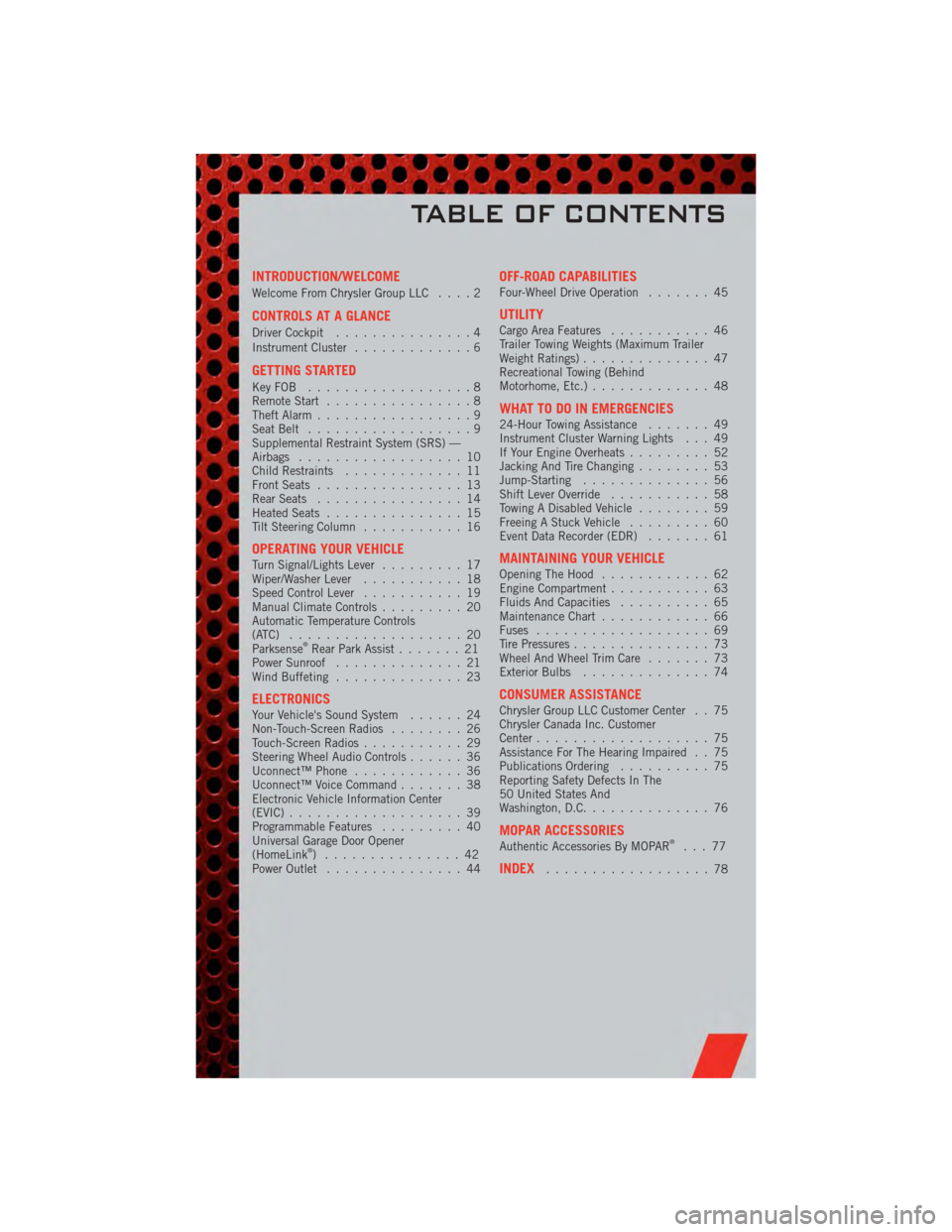
INTRODUCTION/WELCOME
Welcome From Chrysler Group LLC....2
CONTROLS AT A GLANCE
Driver Cockpit...............4
Instrument Cluster .............6
GETTING STARTED
KeyFOB ..................8
Remote Start................8
Theft Alarm .................9
Seat Belt ..................9
Supplemental Restraint System (SRS) —
Airbags ..................10
Child Restraints .............11
Front Seats ................13
Rear Seats ................14
Heated Seats ...............15
Tilt Steering Column ...........16
OPERATING YOUR VEHICLETurn Signal/Lights Lever .........17
Wiper/Washer Lever ...........18
Speed Control Lever ...........19
Manual Climate Controls .........20
Automatic Temperature Controls
(ATC) ...................20
Parksense
®Rear Park Assist .......21
Power Sunroof ..............21
Wind Buffeting ..............23
ELECTRONICSYour Vehicle's Sound System ......24
Non-Touch-Screen Radios ........26
Touch-Screen Radios ...........29
Steering Wheel Audio Controls ......36
Uconnect™ Phone ............36
Uconnect™ Voice Command .......38
Electronic Vehicle Information Center
(EVIC) ...................39
Programmable Features .........40
Universal Garage Door Opener
(HomeLink
®) ...............42
Power Outlet ...............44
OFF-ROAD CAPABILITIESFour-Wheel Drive Operation .......45
UTILITYCargo Area Features...........46
Trailer Towing Weights (Maximum Trailer
Weight Ratings) ..............47
Recreational Towing (Behind
Motorhome, Etc.) .............48
WHAT TO DO IN EMERGENCIES24-Hour Towing Assistance .......49
Instrument Cluster Warning Lights . . . 49
If Your Engine Overheats .........52
Jacking And Tire Changing ........53
Jump-Starting ..............56
Shift Lever Override ...........58
Towing A Disabled Vehicle ........59
Freeing A Stuck Vehicle .........60
Event Data Recorder (EDR) .......61
MAINTAINING YOUR VEHICLEOpening The Hood............62
Engine Compartment ...........63
Fluids And Capacities ..........65
Maintenance Chart ............66
Fuses ...................69
Tire Pressures ...............73
Wheel And Wheel Trim Care .......73
Exterior Bulbs ..............74
CONSUMER ASSISTANCEChrysler Group LLC Customer Center . . 75
Chrysler Canada Inc. Customer
Center...................75
Assistance For The Hearing Impaired . . 75
Publications Ordering ..........75
Reporting Safety Defects In The
50 United States And
Washington, D.C. .............76
MOPAR ACCESSORIESAuthentic Accessories By MOPAR®...77
INDEX..................78
TABLE OF CONTENTS
Page 52 of 84
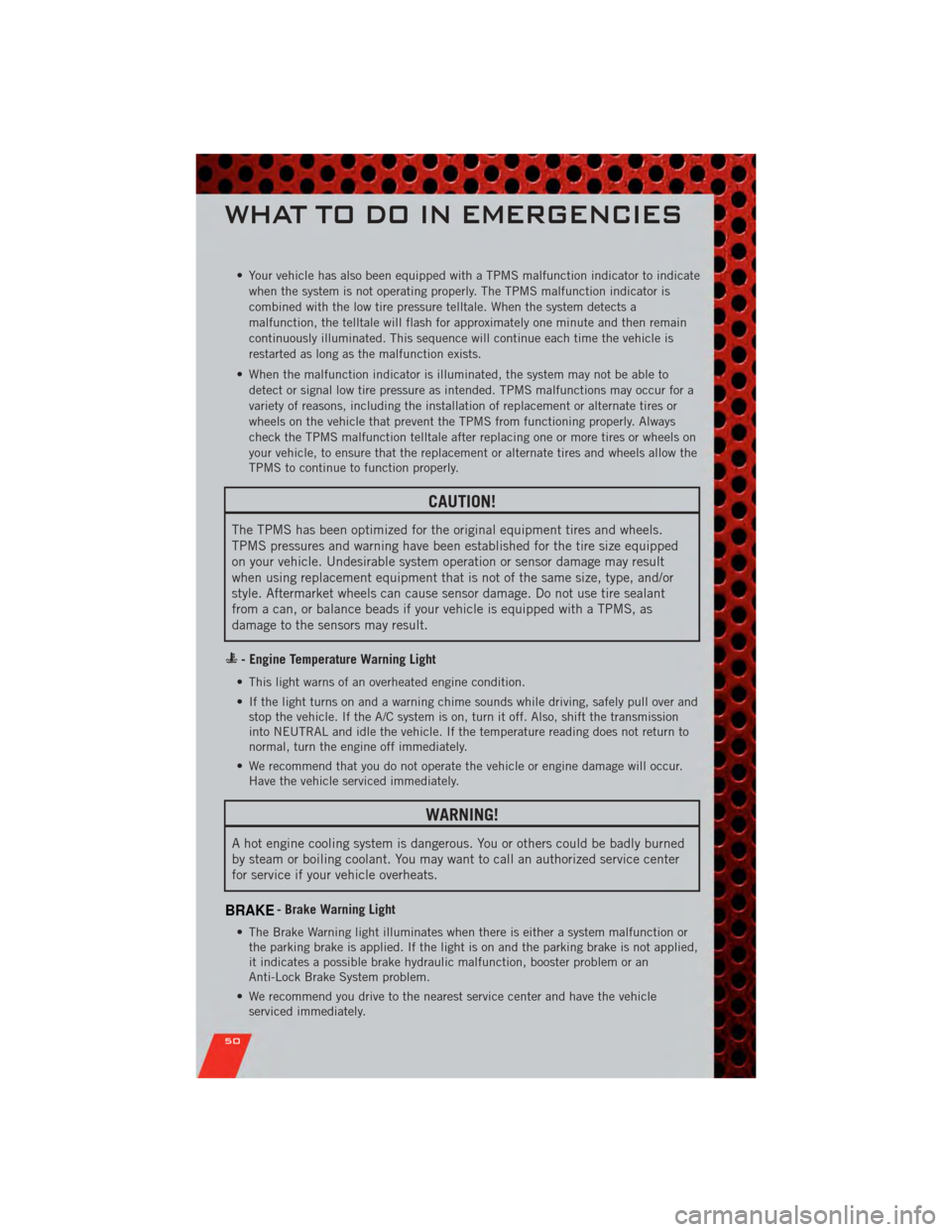
• Your vehicle has also been equipped with a TPMS malfunction indicator to indicatewhen the system is not operating properly. The TPMS malfunction indicator is
combined with the low tire pressure telltale. When the system detects a
malfunction, the telltale will flash for approximately one minute and then remain
continuously illuminated. This sequence will continue each time the vehicle is
restarted as long as the malfunction exists.
• When the malfunction indicator is illuminated, the system may not be able to detect or signal low tire pressure as intended. TPMS malfunctions may occur for a
variety of reasons, including the installation of replacement or alternate tires or
wheels on the vehicle that prevent the TPMS from functioning properly. Always
check the TPMS malfunction telltale after replacing one or more tires or wheels on
your vehicle, to ensure that the replacement or alternate tires and wheels allow the
TPMS to continue to function properly.
CAUTION!
The TPMS has been optimized for the original equipment tires and wheels.
TPMS pressures and warning have been established for the tire size equipped
on your vehicle. Undesirable system operation or sensor damage may result
when using replacement equipment that is not of the same size, type, and/or
style. Aftermarket wheels can cause sensor damage. Do not use tire sealant
from a can, or balance beads if your vehicle is equipped with a TPMS, as
damage to the sensors may result.
- Engine Temperature Warning Light
• This light warns of an overheated engine condition.
• If the light turns on and a warning chime sounds while driving, safely pull over andstop the vehicle. If the A/C system is on, turn it off. Also, shift the transmission
into NEUTRAL and idle the vehicle. If the temperature reading does not return to
normal, turn the engine off immediately.
• We recommend that you do not operate the vehicle or engine damage will occur. Have the vehicle serviced immediately.
WARNING!
A hot engine cooling system is dangerous. You or others could be badly burned
by steam or boiling coolant. You may want to call an authorized service center
for service if your vehicle overheats.
BRAKE- Brake Warning Light
• The Brake Warning light illuminates when there is either a system malfunction orthe parking brake is applied. If the light is on and the parking brake is not applied,
it indicates a possible brake hydraulic malfunction, booster problem or an
Anti-Lock Brake System problem.
• We recommend you drive to the nearest service center and have the vehicle serviced immediately.
WHAT TO DO IN EMERGENCIES
50
Page 54 of 84
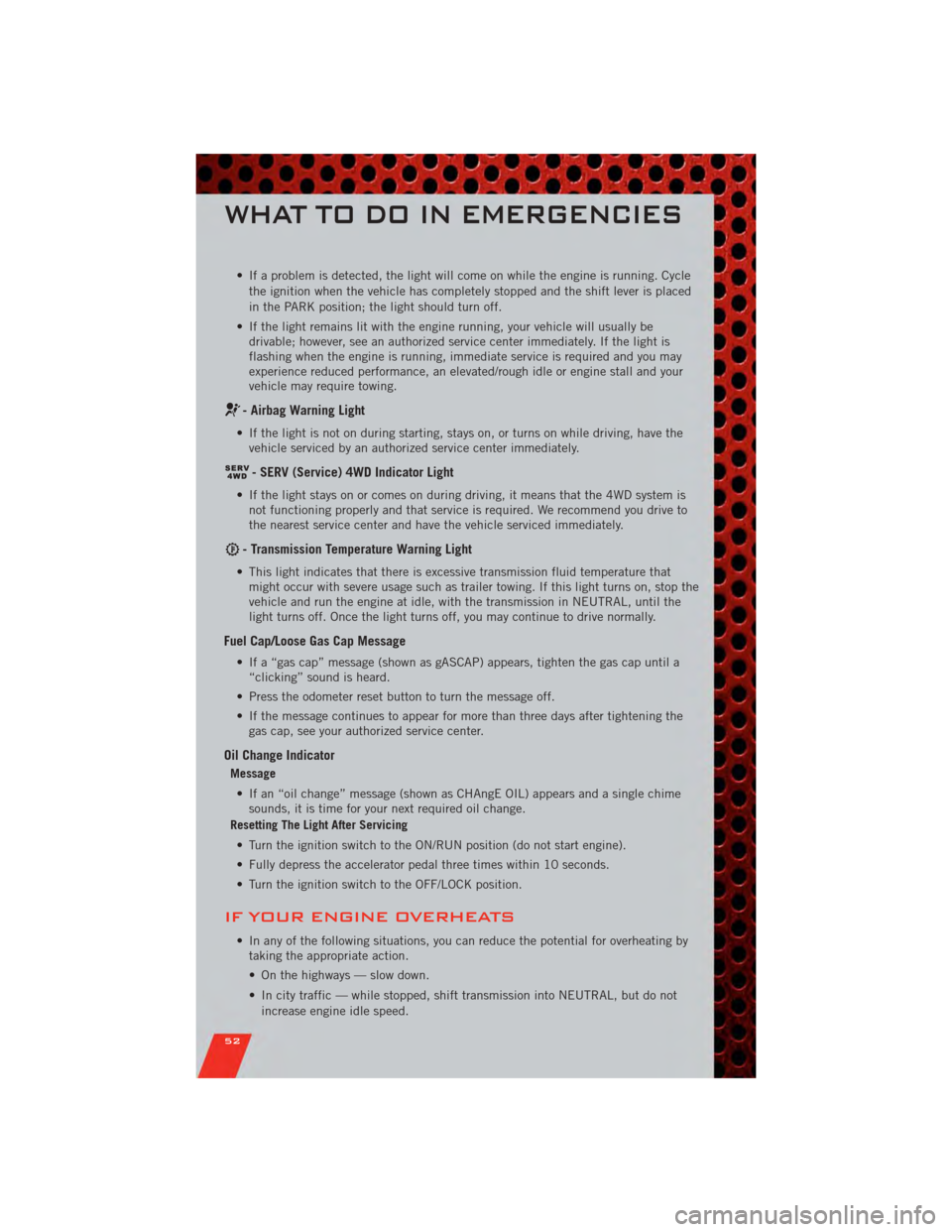
• If a problem is detected, the light will come on while the engine is running. Cyclethe ignition when the vehicle has completely stopped and the shift lever is placed
in the PARK position; the light should turn off.
• If the light remains lit with the engine running, your vehicle will usually be drivable; however, see an authorized service center immediately. If the light is
flashing when the engine is running, immediate service is required and you may
experience reduced performance, an elevated/rough idle or engine stall and your
vehicle may require towing.
- Airbag Warning Light
• If the light is not on during starting, stays on, or turns on while driving, have thevehicle serviced by an authorized service center immediately.
- SERV (Service) 4WD Indicator Light
• If the light stays on or comes on during driving, it means that the 4WD system isnot functioning properly and that service is required. We recommend you drive to
the nearest service center and have the vehicle serviced immediately.
- Transmission Temperature Warning Light
• This light indicates that there is excessive transmission fluid temperature thatmight occur with severe usage such as trailer towing. If this light turns on, stop the
vehicle and run the engine at idle, with the transmission in NEUTRAL, until the
light turns off. Once the light turns off, you may continue to drive normally.
Fuel Cap/Loose Gas Cap Message
• If a “gas cap” message (shown as gASCAP) appears, tighten the gas cap until a“clicking” sound is heard.
• Press the odometer reset button to turn the message off.
• If the message continues to appear for more than three days after tightening the gas cap, see your authorized service center.
Oil Change Indicator
Message
• If an “oil change” message (shown as CHAngE OIL) appears and a single chime sounds, it is time for your next required oil change.
Resetting The Light After Servicing
• Turn the ignition switch to the ON/RUN position (do not start engine).
• Fully depress the accelerator pedal three times within 10 seconds.
• Turn the ignition switch to the OFF/LOCK position.
IF YOUR ENGINE OVERHEATS
• In any of the following situations, you can reduce the potential for overheating by taking the appropriate action.
• On the highways — slow down.
• In city traffic — while stopped, shift transmission into NEUTRAL, but do not
increase engine idle speed.
WHAT TO DO IN EMERGENCIES
52
Page 55 of 84
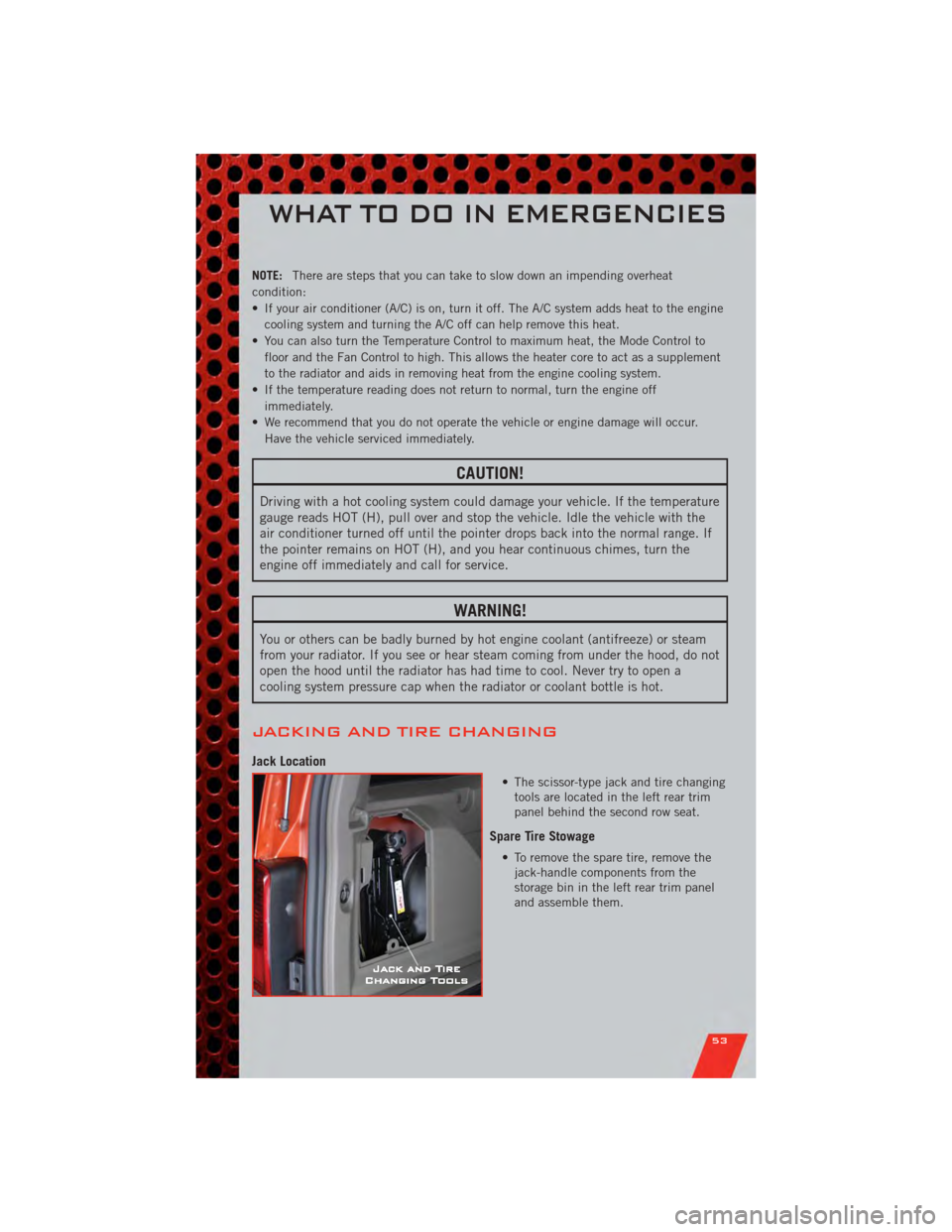
NOTE:There are steps that you can take to slow down an impending overheat
condition:
• If your air conditioner (A/C) is on, turn it off. The A/C system adds heat to the engine cooling system and turning the A/C off can help remove this heat.
• You can also turn the Temperature Control to maximum heat, the Mode Control to floor and the Fan Control to high. This allows the heater core to act as a supplement
to the radiator and aids in removing heat from the engine cooling system.
• If the temperature reading does not return to normal, turn the engine off immediately.
• We recommend that you do not operate the vehicle or engine damage will occur. Have the vehicle serviced immediately.
CAUTION!
Driving with a hot cooling system could damage your vehicle. If the temperature
gauge reads HOT (H), pull over and stop the vehicle. Idle the vehicle with the
air conditioner turned off until the pointer drops back into the normal range. If
the pointer remains on HOT (H), and you hear continuous chimes, turn the
engine off immediately and call for service.
WARNING!
You or others can be badly burned by hot engine coolant (antifreeze) or steam
from your radiator. If you see or hear steam coming from under the hood, do not
open the hood until the radiator has had time to cool. Never try to open a
cooling system pressure cap when the radiator or coolant bottle is hot.
JACKING AND TIRE CHANGING
Jack Location
• The scissor-type jack and tire changingtools are located in the left rear trim
panel behind the second row seat.
Spare Tire Stowage
• To remove the spare tire, remove thejack-handle components from the
storage bin in the left rear trim panel
and assemble them.
WHAT TO DO IN EMERGENCIES
53
Page 62 of 84
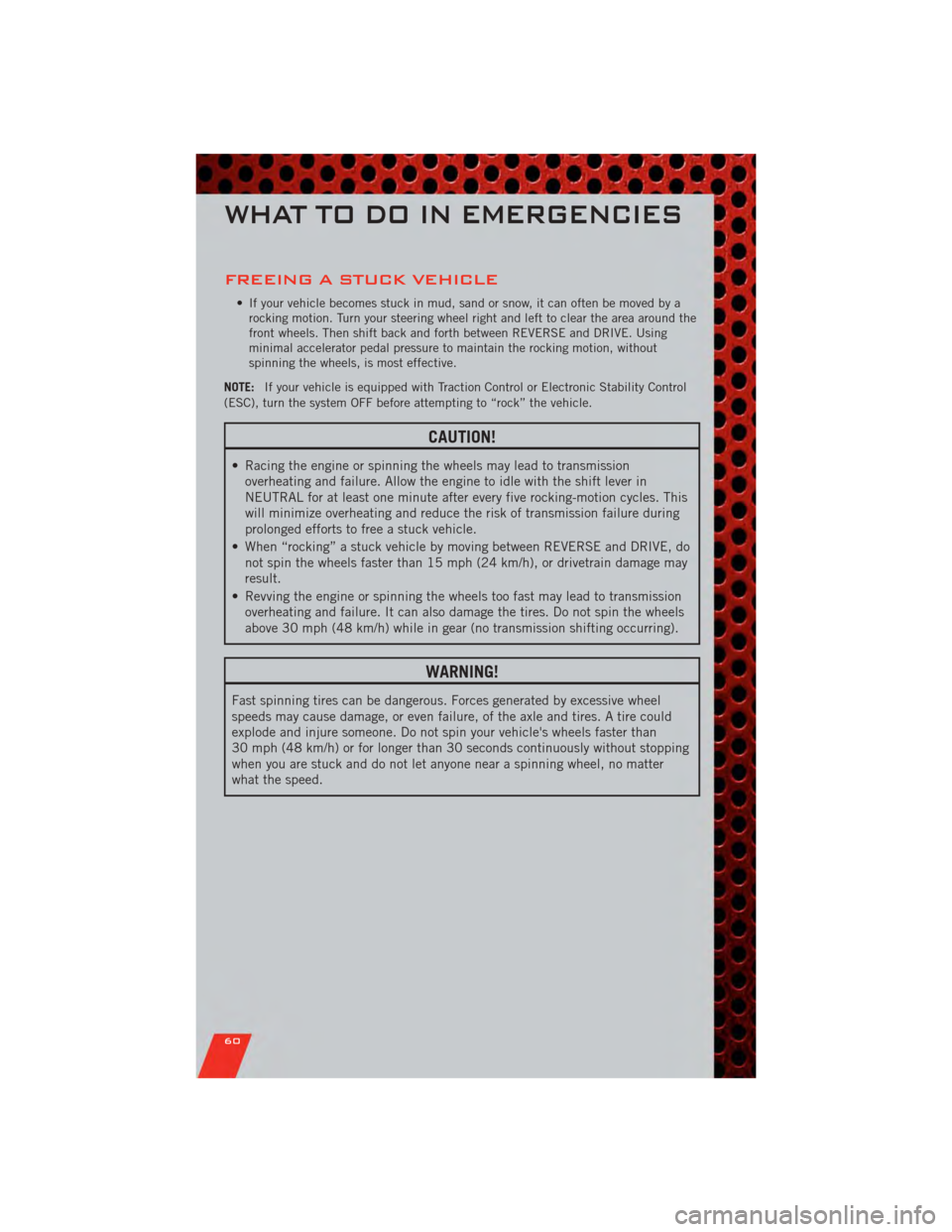
FREEING A STUCK VEHICLE
• If your vehicle becomes stuck in mud, sand or snow, it can often be moved by arocking motion. Turn your steering wheel right and left to clear the area around the
front wheels. Then shift back and forth between REVERSE and DRIVE. Using
minimal accelerator pedal pressure to maintain the rocking motion, without
spinning the wheels, is most effective.
NOTE: If your vehicle is equipped with Traction Control or Electronic Stability Control
(ESC), turn the system OFF before attempting to “rock” the vehicle.
CAUTION!
• Racing the engine or spinning the wheels may lead to transmission overheating and failure. Allow the engine to idle with the shift lever in
NEUTRAL for at least one minute after every five rocking-motion cycles. This
will minimize overheating and reduce the risk of transmission failure during
prolonged efforts to free a stuck vehicle.
• When “rocking” a stuck vehicle by moving between REVERSE and DRIVE, do not spin the wheels faster than 15 mph (24 km/h), or drivetrain damage may
result.
• Revving the engine or spinning the wheels too fast may lead to transmission overheating and failure. It can also damage the tires. Do not spin the wheels
above 30 mph (48 km/h) while in gear (no transmission shifting occurring).
WARNING!
Fast spinning tires can be dangerous. Forces generated by excessive wheel
speeds may cause damage, or even failure, of the axle and tires. A tire could
explode and injure someone. Do not spin your vehicle's wheels faster than
30 mph (48 km/h) or for longer than 30 seconds continuously without stopping
when you are stuck and do not let anyone near a spinning wheel, no matter
what the speed.
WHAT TO DO IN EMERGENCIES
60
Page 80 of 84
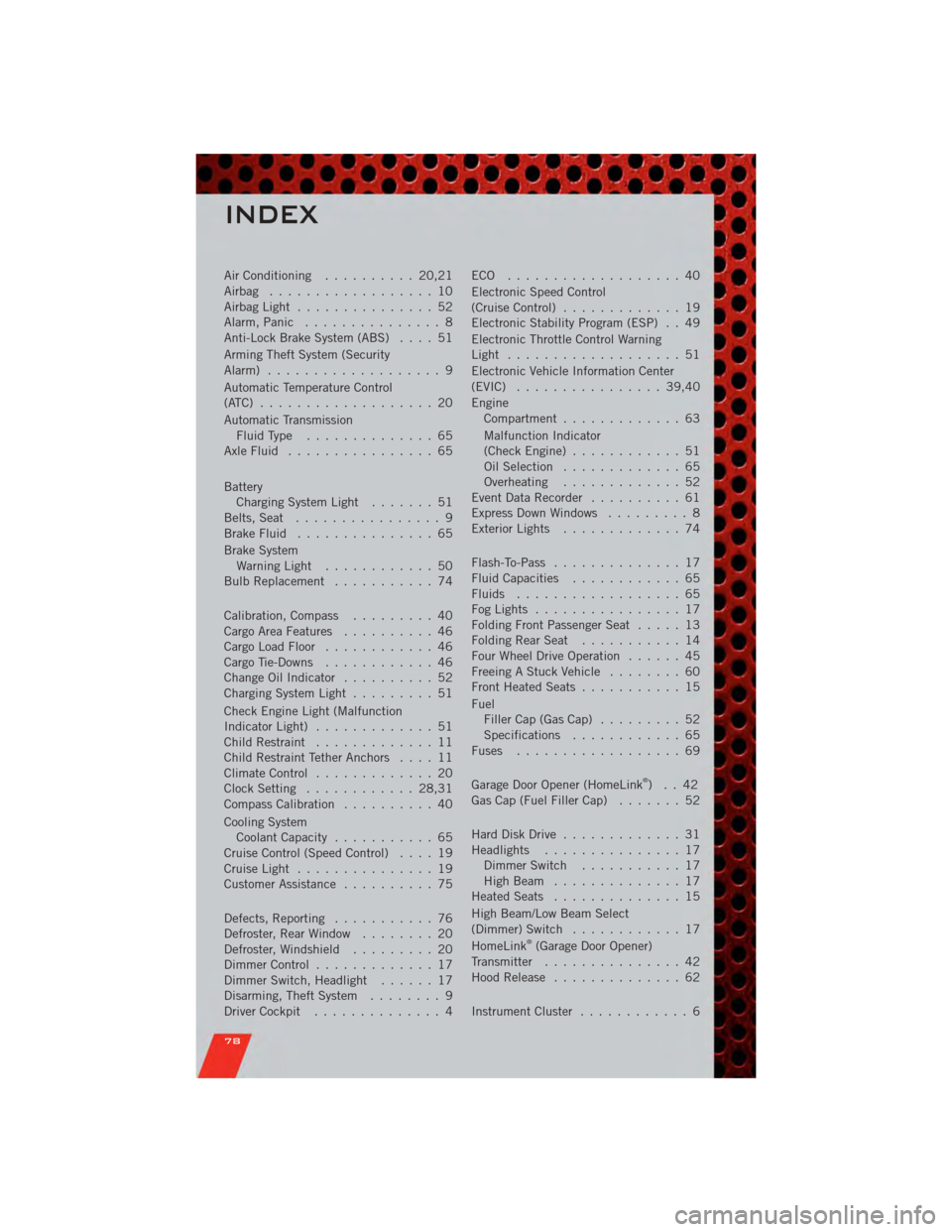
Air Conditioning.......... 20,21
Airbag .................. 10
AirbagLight ............... 52
Alarm, Panic ............... 8
Anti-Lock Brake System (ABS) .... 51
Arming Theft System (Security
Alarm) ................... 9
Automatic Temperature Control
(ATC) ................... 20
Automatic Transmission FluidType .............. 65
AxleFluid ................ 65
Battery Charging System Light ....... 51
Belts, Seat ................ 9
BrakeFluid ............... 65
Brake System WarningLight ............ 50
Bulb Replacement ........... 74
Calibration, Compass ......... 40
Cargo Area Features .......... 46
CargoLoadFloor ............ 46
Cargo Tie-Downs ............ 46
Change Oil Indicator .......... 52
Charging System Light ......... 51
Check Engine Light (Malfunction
Indicator Light) ............. 51
Child Restraint ............. 11
Child Restraint Tether Anchors .... 11
ClimateControl ............. 20
Clock Setting ............ 28,31
Compass Calibration .......... 40
Cooling System Coolant Capacity ........... 65
Cruise Control (Speed Control) .... 19
CruiseLight ............... 19
Customer Assistance .......... 75
Defects, Reporting ........... 76
Defroster, Rear Window ........ 20
Defroster, Windshield ......... 20
Dimmer Control ............. 17
Dimmer Switch, Headlight ...... 17
Disarming, Theft System ........ 9
Driver Cockpit .............. 4 ECO ................... 40
Electronic Speed Control
(CruiseControl) ............. 19
Electronic Stability Program (ESP) . . 49
Electronic Throttle Control Warning
Light ................... 51
Electronic Vehicle Information Center
(EVIC) ................ 39,40
Engine
Compartment ............. 63
Malfunction Indicator
(CheckEngine) ............ 51
Oil Selection ............. 65
Overheating ............. 52
EventDataRecorder .......... 61
Express Down Windows ......... 8
Exterior Lights ............. 74
Flash-To-Pass .............. 17
Fluid Capacities ............ 65
Fluids .................. 65
FogLights ................ 17
Folding Front Passenger Seat ..... 13
FoldingRearSeat ........... 14
Four Wheel Drive Operation ...... 45
Freeing A Stuck Vehicle ........ 60
Front Heated Seats ........... 15
Fuel Filler Cap (Gas Cap) ......... 52
Specifications ............ 65
Fuses .................. 69
Garage
Door Opener (HomeLink
®)..42
Gas Cap (Fuel Filler Cap) ....... 52
Hard Disk Drive ............. 31
Headlights ............... 17 Dimmer Switch ........... 17
HighBeam .............. 17
Heated Seats .............. 15
High Beam/Low Beam Select
(Dimmer) Switch ............ 17
HomeLink
®(Garage Door Opener)
Transmitter ............... 42
Hood Release .............. 62
InstrumentCluster ............ 6
INDEX
78
Page 81 of 84
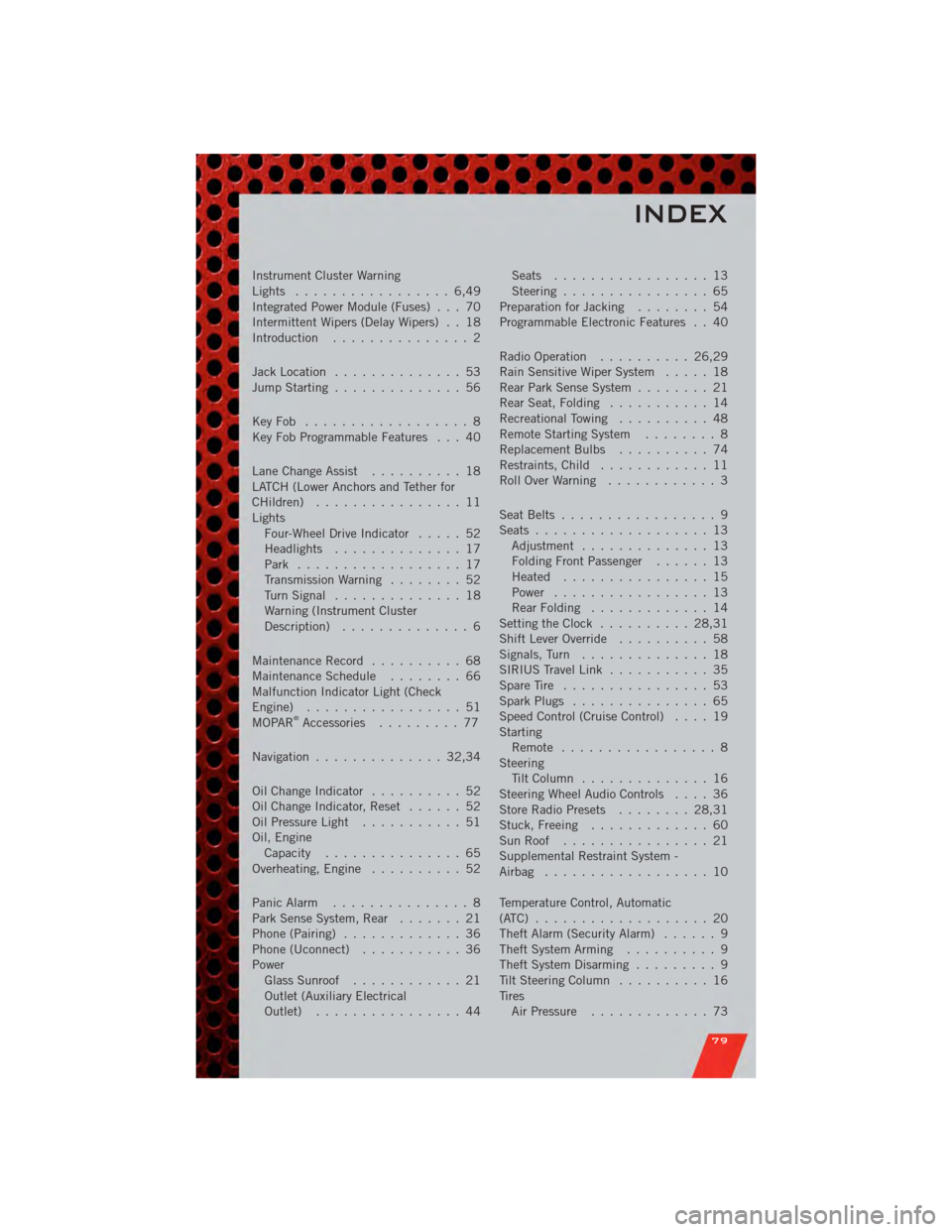
Instrument Cluster Warning
Lights ................. 6,49
Integrated Power Module (Fuses) . . . 70
Intermittent Wipers (Delay Wipers) . . 18
Introduction............... 2
Jack Location .............. 53
Jump Starting .............. 56
KeyFob .................. 8
Key Fob Programmable Features . . . 40
Lane Change Assist .......... 18
LATCH (Lower Anchors and Tether for
CHildren) ................ 11
Lights Four-Wheel Drive Indicator ..... 52
Headlights .............. 17
Park .................. 17
Transmission Warning ........ 52
TurnSignal .............. 18
Warning (Instrument Cluster
Description) .............. 6
Maintenance Record .......... 68
MaintenanceSchedule ........ 66
Malfunction Indicator Light (Check
Engine) ................. 51
MOPAR
®Accessories ......... 77
Navigation .............. 32,34
OilChangeIndicator .......... 52
Oil Change Indicator, Reset ...... 52
Oil Pressure Light ........... 51
Oil, Engine Capacity ............... 65
Overheating, Engine .......... 52
Panic Alarm ............... 8
Park Sense System, Rear ....... 21
Phone (Pairing) ............. 36
Phone (Uconnect) ........... 36
Power Glass Sunroof ............ 21
Outlet (Auxiliary Electrical
Outlet) ................ 44 Seats
................. 13
Steering ................ 65
Preparation for Jacking ........ 54
Programmable Electronic Features . . 40
Radio Operation .......... 26,29
Rain Sensitive Wiper System ..... 18
Rear Park Sense System ........ 21
Rear Seat, Folding ........... 14
Recreational Towing .......... 48
Remote Starting System ........ 8
ReplacementBulbs .......... 74
Restraints, Child ............ 11
RollOverWarning ............ 3
Seat Belts ................. 9
Seats ................... 13
Adjustment .............. 13
Folding Front Passenger ...... 13
Heated ................ 15
Power ................. 13
RearFolding ............. 14
Setting the Clock .......... 28,31
Shift Lever Override .......... 58
Signals, Turn .............. 18
SIRIUS Travel Link ........... 35
SpareTire ................ 53
SparkPlugs ............... 65
Speed Control (Cruise Control) .... 19
Starting Remote ................. 8
Steering TiltColumn .............. 16
Steering Wheel Audio Controls .... 36
Store Radio Presets ........ 28,31
Stuck, Freeing ............. 60
SunRoof ................ 21
Supplemental Restraint System -
Airbag .................. 10
Temperature Control, Automatic
(ATC) ................... 20
Theft Alarm (Security Alarm) ...... 9
Theft System Arming .......... 9
Theft System Disarming ......... 9
Tilt Steering Column .......... 16
Tires Air Pressure ............. 73
INDEX
79